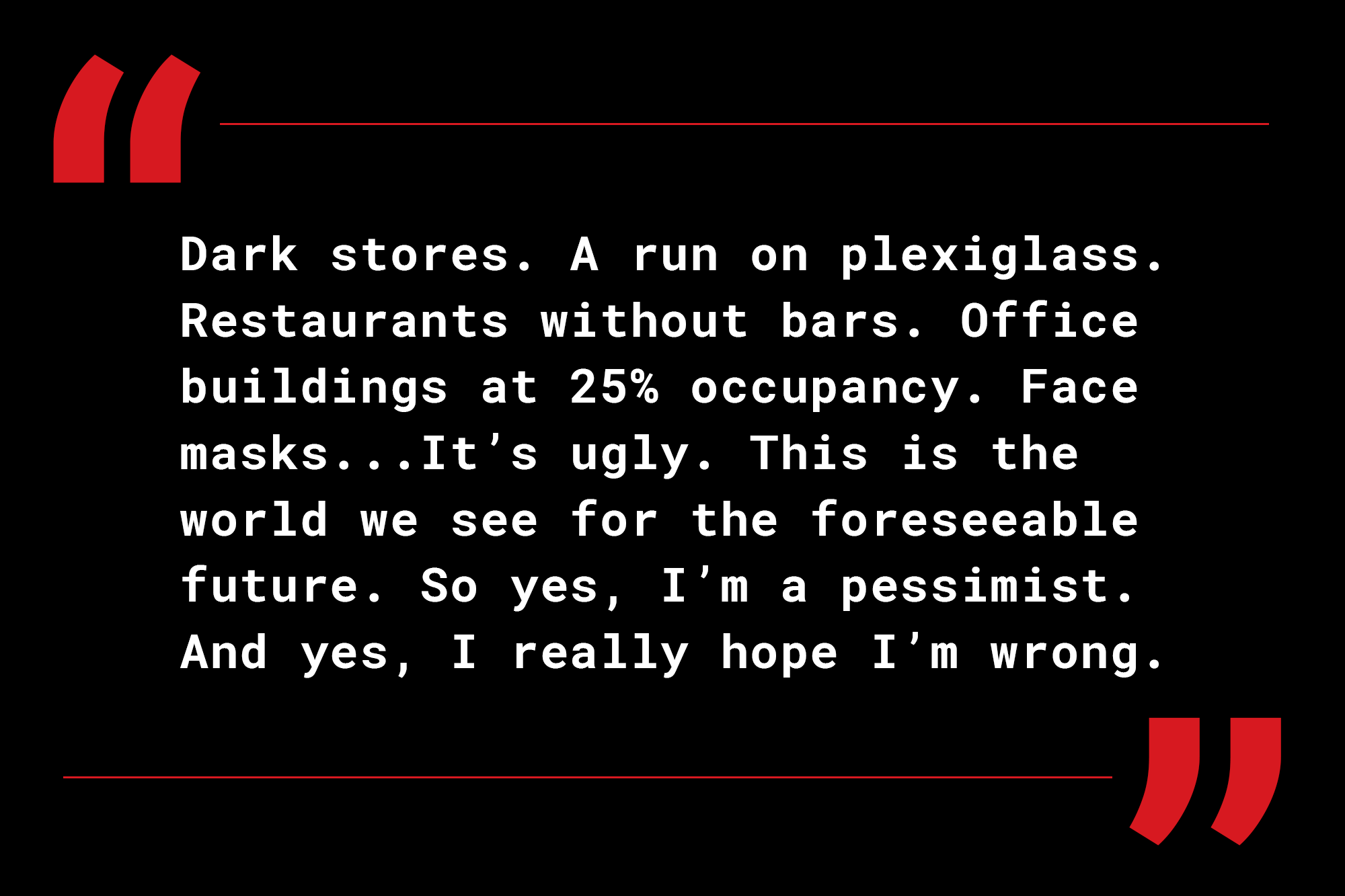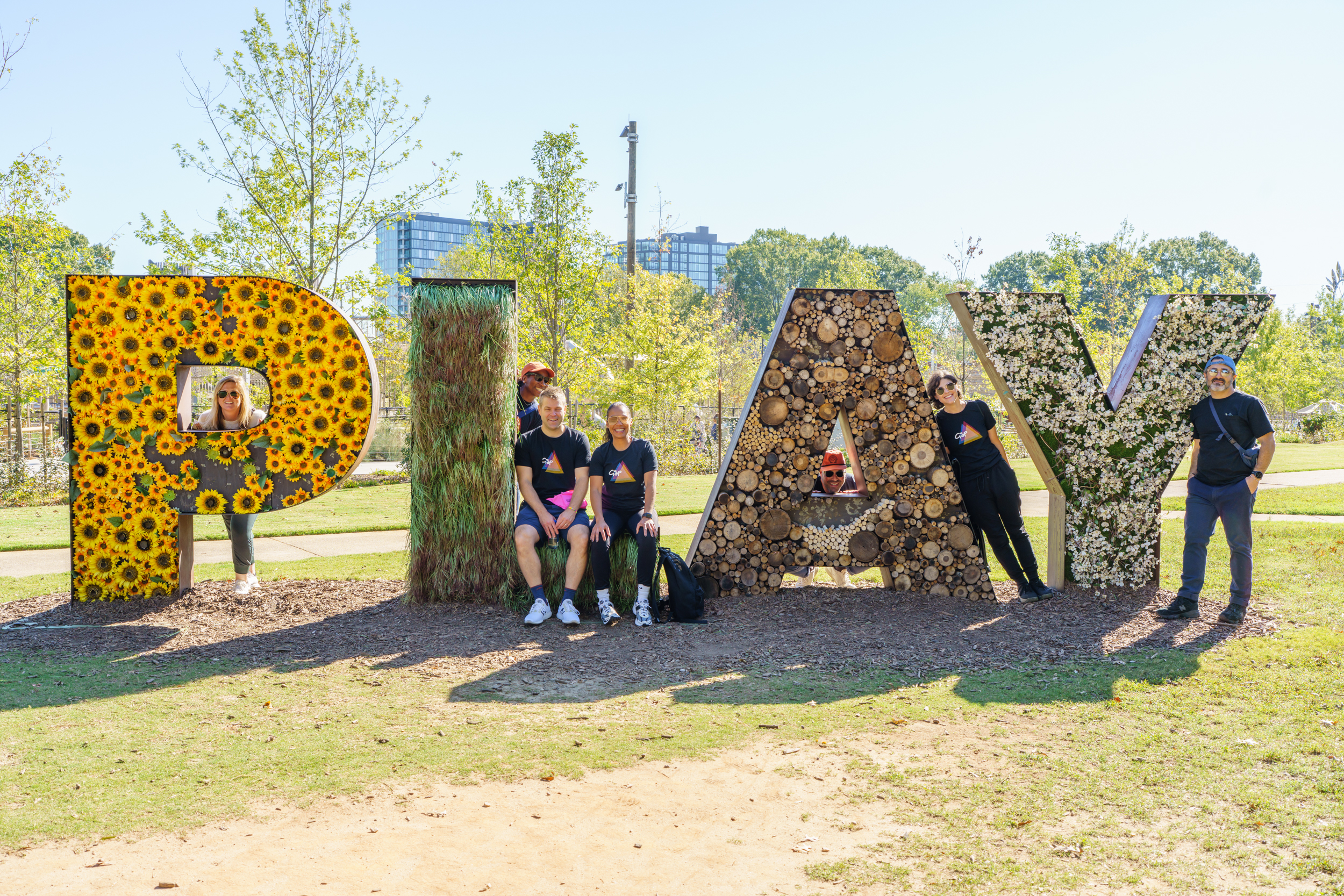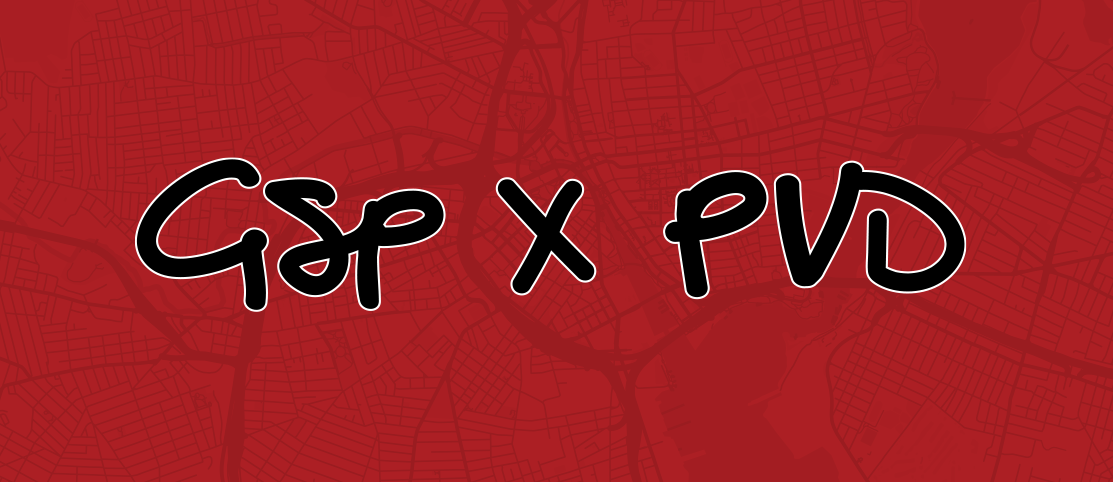Update #10: I Hope I’m Wrong
Dear Clients and Colleagues,
Before coronavirus, I was an optimist. A cautious optimist, but for sure an optimist. I miss those days.
Today – and as of sometime mid-March – I’m a resolute pessimist as it relates to our collective ability as a business community to manage, understand, and forecast this crisis. I’m totally owning my newfound pessimism, and in a sort of perverse way it feels good to root against myself right now. Every day I say “I hope I’m wrong, but…” 7 or 8 times. And I do hope I’m wrong about much of what I am thinking right now re: retail real estate.
But at Graffito we simply don’t see the benefit of planning for or assuming the best case scenario right now (Wall Street is apparently taking the opposite approach of late). Despite this negativity, I’m confident in Graffito’s ability (and our clients, partners and collaborators) to weather this crisis, and there is a lot of stuff that I’m really excited about in our work, but it does mean that I’m just not drinking the kool-aid as related to any sort of successful reopening for retail establishments over the coming months. I’m extremely doubtful our recovery will be v-shaped. And while I hate being that guy that hears good news and takes the half-empty outlook, I have become that guy… And here at Graffito we’ve all embraced a strategy of not bull-shitting each other or our clients. And I guess being a realist right now just feels and looks a lot like being a pessimist.
Here’s a quick example of where my head is at:
Restaurants reopening should be good news, right? Optimist Jesse of 2019 would say “Hell yeah, these restaurateurs will figure it out, there’s pent-up demand, no operator gets food safety like chefs, especially the locals — they’ll pivot and find new opportunities… oh, and it’s almost summer… outdoor seating!!”
But newly-minted pessimist Jesse sees supply that far outpaces any sort of “pent-up demand,” as we are seeing sales decline at many restaurants of late because of all the re-openings, with many more to come. And here’s more: there will be fewer students in our cities this fall (and by extension fewer faculty and staff), no parent weekends, and no collegiate sports; work from home policies that are in place now are being extended through 2020 for many of the area’s largest employers (thus killing weekday lunches in many commercial business districts, as well as private events, corporate parties, restaurant buy-outs, etc); a food delivery system that is dominated by big players, which makes little economic, social or ethical sense (just read this for a taste); reduced occupancy in all places of public accommodation; and, most importantly, a public health crisis that is closer to the beginning than the end… This is what is coming whether or not we want to accept it.
I know this is hard to read for some. It’s hard to write too. But we need to grasp the gravity of this crisis in retail if we are going to start to make moves to recover responsibly. Part of our recovery here at Graffito means digging deeper into issues that we previously touched and cared about, but weren’t the focus of our everyday dealings or thinking. As follows are three topics we are increasingly putting more time into understanding, which were more tangential to our work pre-coronavirus:
1. Curbside Management. As I’ve hinted at in prior updates, and as Corey has done a really great job framing in her weekly restaurant retrofit posts, we need to be thinking about both (i) changes to the in-store retail and restaurant experience and also (ii) major modifications to the way we design and retrofit building edges to better connect public and private realm. Most in our industry are currently fixated on the in-store pivots right now, though we are increasingly more focused on the latter. And today we are thinking more about curbside management than ever. How do retailers get their goods from their premises to their customers’ cars? How do pedestrians queue outside of shops? How can we work with cities to repurpose sidewalks and streets to enhance the retail experience (and add usable space)? Further, as Corey wrote in her May 8th post: The question many want to know is what will be lasting impacts of the COVID-crisis for our public realm and design of ground floor spaces? How can the line between storefront and street be designed for both porosity and protection? And how will this be reconciled with the inevitable changes inside and around the building, with the public realm and streetscape? No clear answers yet, but lots to contemplate.
2. Supply Chain Realities. Both global and hyper-local retailers are dealing with major supply chain challenges. Many Main Street shops are impacted by factory production in China and restaurants in the Northeast need non-indigenous products like olive oil, coffee and citrus. But it’s other supply chain complexities that have surfaced of late that are giving me the most pause. And it’s the unavoidable uncertainty I wrote about in Update #5 that is wildly difficult for manufacturers to deal with. And there are just too many unknowns right now (and not enough capital) for many retailers to place orders for product that will be needed months from now. So that jacket you may need this fall? Well, it’s not in production yet. The plexiglass for your office or restaurant? Good luck, because six months ago we weren’t making enough of it. Movable furniture for the outdoor spaces we all want to (safely) use this summer? Backorder. More bike racks needed for your building because (a) people don’t want to use that awkward bike room with no ventilation in the parking garage and (b) more people are biking this summer than expected, right? You guessed it — back order on bike racks too. Simply put, our economy is not yet set up for the new world order in the coronavirus era. We saw this with the supply of toilet paper, hand sanitizer and dry goods in March; we will see this with all sorts of other goods during the rest of 2020. This inevitable gap between supply and demand is a bad thing for retail, for consumers, and for those of us that have creative work-arounds for new problems but can’t get the hardware we need for such remedies.
3. Acceleration of E-commerce. This is the biggie. It was coming. But man, not this quick. We squeezed about 5 years of e-commerce absorption into about 5 weeks. This impact here is so vast it’s hard to even quantify right now. But we are seeing billions of dollars shift from real estate investment to AI investment. Facebook is all in now (see: Facebook rolls out Shop). So is Target, Walmart, Kroger, etc. Online grocery orders are off the charts. Online shopping across the board has exploded (too many studies and articles to site for this one). There is just no turning back from this shift to online commerce. Sure, shoppers will return to stores, but not in pre-coronavirus numbers. We all have that family member that we never thought would buy sneakers online… well, they just did. And they probably just realized that it was really, really easy. For some there’s a glimmer of hope that retail real estate can coexist and hold it’s value alongside this shift to e-commerce, but the only credible arguments I’ve come across are anchored by the claim brick and mortar locations will just shift to “fulfillment centers” for online orders. I don’t buy this though, because the shoppers that are just going to a store to pick up something purchased online will behave very differently than the shopper of yesterday. The real estate needs of these retailers will shift too. Shopping districts are going to feel a lot different when retail stores function like this. Even scarier is when retail stores only function as fulfillment centers. And if you’ve yet to hear the term “dark store,” here you go: Whole Foods continues to open online-only ‘dark’ stores.
Dark stores. A run on plexiglass. Restaurants without bars. Office buildings at 25% occupancy. Face masks… It’s ugly. This is the world we see for the foreseeable future. So yes, I’m a pessimist. And yes, I really hope I’m wrong…
More next week in update #11. And way more optimism too, I promise!
/Jesse





May 21, 2020 2:33 pm /
To be an independent restaurateur is to be an optimist by nature, but I too am in a dark mood about the foreseeable future. Worker safety, opening dates, masks, capacity issues …sure. But as you say in your blog my real concern in Cambridge is that the customer base is gone; big businesses are staying home, colleges and universities don’t know what to do, but most importantly the average urban citizen in the Northeast is worried for their safety. I don’t think they will be coming back out anytime soon. The people will decide when things reopen and they are not ready to take the risk until there is better testing and tracing but more importantly leadership. Who or what will convince them that they are safe in the marketplace?
I found this OpEd in the New York Times by the tech/media journalist Charlie Worzel absolutely frightening:
https://www.nytimes.com/2020/05/20/opinion/coronavirus-restaurant-montana.html